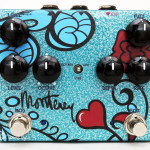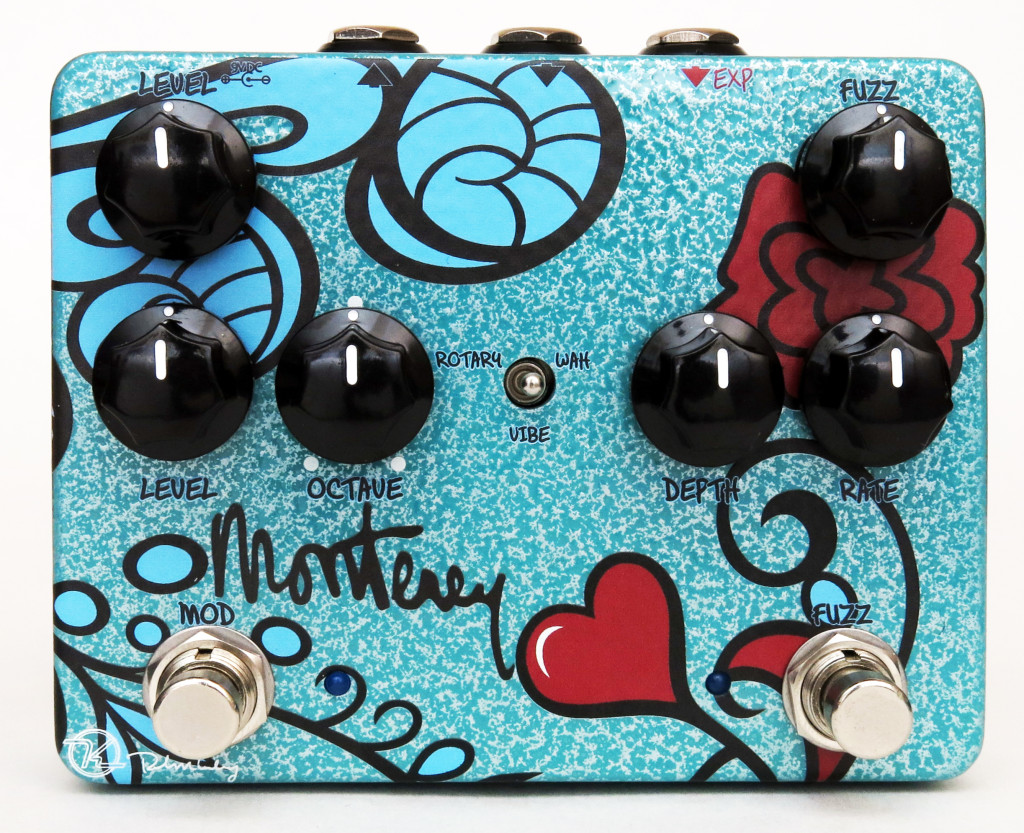 Arriving in a suave black velvet bag, the latest offering from effects Guru Robert Keeley, the Keeley Monterey Rotary Fuzz Vibe pedal strikes with immediate eye appeal adorned with its groovy painted enclosure, very reminiscent of the painted guitar Hendrix sacrificed at the pedal’s namesake festival in 1967. It’s a very appealing aesthetic, very ’67 and still contemporary enough to look great on a modern pedalboard.
Arriving in a suave black velvet bag, the latest offering from effects Guru Robert Keeley, the Keeley Monterey Rotary Fuzz Vibe pedal strikes with immediate eye appeal adorned with its groovy painted enclosure, very reminiscent of the painted guitar Hendrix sacrificed at the pedal’s namesake festival in 1967. It’s a very appealing aesthetic, very ’67 and still contemporary enough to look great on a modern pedalboard.
Rooted in the classic tones of the past, but far more promising in the pursuit of new and different sounds, the workstation appellation is indeed accurate in that given the number of sounds available through the various permutations, you’ll have plenty to keep you busy. It’s definitely a really hands-on pedal, but it also keeps your hands on the guitar, too. There’s a lot to check out, so let’s take a look.
For bringing the pedal to life, I employed an early 70s Marshall 50-watt half stack (set to a reticent crunch) for getting some period-correct base sounds, and a Carvin 60-watt head run clean and loud into another Marshall 4×12 cab. For the main guitar, a stock 1974 Strat with a maple neck addressed the Jimi vibe, while a korina Vee-style provided some contrast.
Despite the amount of knobs and options, the Monterey’s control layout isn’t imposing and, after a quick glance, you know where you are. There are two channels; on the right is the Fuzz section, activated by the stomp switch below. The Monterey’s Fuzz section truly lives up to its name, delivering a smoother gain than more faithful fuzz face variants. It’s a good blend of germanium warmth and silicon sustain. Built around vintage Fairchild Semiconductor transistors, these medium-gain beauties give the Monterey a very consistent fuzz sound that adjusts easily. The fuzz is very touch sensitive and cleans up well with your guitar volume knob, and this is a key theme repeated through the various sound on the Monterey; all of them react very closely to your playing.
The fuzz covers plenty of territory, from early Are You Experienced Hendrix right up through the more aggressive, stinging sounds on Band of Gypsies and beyond. Not rooted solely in Jimi-land, I was able to conjure a very cool David Gilmour Pompeii-style sustain by nearly maxing out the Fuzz knob and pushing the volume (level) a bit more. Searing but not sputtering, the Monterey tracks fast lines and remains cohesive when pushed hard by pick attack. A backwards roll of the volume brings it back down through a Mick Ronson-esque honk to an edgy clean sound that snarls just enough when you need it to. Another cool fuzz feature; set the Rate OFF for no rotation, turn the Fuzz on, and the Depth and Octave controls give you a sweet speaker cabinet simulation. It’s a fuzz cornucopia with tonal control like you’ve never heard before; ideal for tweaking blown-out sounds with a little random precision. Perfect for matching any size of power amp with the pedal’s fuzz to give you anything from dark overdrive to hard, edgy, squared fuzz!
Wow, that was intense and I’ve only tried one effect so far!
Letting the fuzz fizzle for a moment, it’s time to take a pass at the Vibe section of the Monterey. Through the big Carvin clean channel, the Vibe provided very deep, throbbing pulses that you could feel in the floor. From a slow wobble to a dizzying spin, the combination of the phasing and tremolo at key frequencies give the effect an incredible organic depth and a 3-D feel. Running it through the Marshall half stack with a little crunch had us crossing the Bridge of Sighs within moments, resulting in a room-rattling pulse and a physically-viable soundstage. Getting there is half the fun, because this pedal is so cool that you almost intuitively know how to tweak the controls to get what you need from it on the fly. While that sound was going, I added a little high octave doubling for a very cool pass at a Band of Gypsies lead sound, a la Machine Gun and Them Changes. Not only does it match the frequency response of a vibe, it simulates the unique pulsing of a photo-cell based effect, too. You can add the Octave to the “Kool Vibe” for an amazing doubling effect or for an incredibly deep synth bass type sound. While the Jimi influence and sounds abound in the Monterey, it’s the potential for working up many other period correct sounds and the potential for creating new sounds that makes it so fun and useful.
 Speaking of classic sounds, the Rotary effect of the Monterey is both tonally accurate and has a more modern take on the sound. The simulation blends both the upper and lower horns (just like the real thing) of the cabinet that produces a very rich and (again!) dimensional soundstage, even though a smaller amp. Some thoughtful tweaking of the sim adds short cabinet reverb reflections for a pleasing doubling effect, adding a chorus, ethereal quality. In the clean channel, the sweep and rise of the sound is physical, creating numerous overtones and a warm, enveloping state in front of an amp. For more versatility, the Octave Control in the Rotary cabinet simulation setting controls the volume of the horn or tweeter sounds.
Speaking of classic sounds, the Rotary effect of the Monterey is both tonally accurate and has a more modern take on the sound. The simulation blends both the upper and lower horns (just like the real thing) of the cabinet that produces a very rich and (again!) dimensional soundstage, even though a smaller amp. Some thoughtful tweaking of the sim adds short cabinet reverb reflections for a pleasing doubling effect, adding a chorus, ethereal quality. In the clean channel, the sweep and rise of the sound is physical, creating numerous overtones and a warm, enveloping state in front of an amp. For more versatility, the Octave Control in the Rotary cabinet simulation setting controls the volume of the horn or tweeter sounds.
Speaking of the octave doubling, here’s where things get a little more interesting; the octave doubling effect goes both ways. The Octave knob at high noon is where the effect is completely off. By turning the knob clockwise, you add the high octave, and, by going counterclockwise, you add the low octave. Adding the high octave is where you catch the Band of Gypsies vibe, while going low offers a strong, almost synth-like feel. This effect could be interesting with a chord/walking bassline arrangement, among other things. Like all of the other sounds in the Monterey, blending/combining the Octave effect with the others is where it’s at. Like the auto wah, the Octave is one of those effects that seems a little kinky and dangerous, but you can’t help yourself from thinking “Well, maybe just a little bit…,” and we all know where that leads!
Not just one, but three wah-wah variations are available in the Monterey. There’s a fixed or cocked wah sound, an auto wah, a harmonic/tremolo wah, and even a regular foot-controlled wah when you add an expression pedal. While not included with the Monterey, it would enable you to create additional madness elsewhere. With the Expression pedal, the wah operation is more flexible, but even on its own, the effect produced a crisp, funky Crybaby sound. Fueled by some fuzz, the wah gives you a total “Let’s go Crazy” scream. Turn the Depth control up a slight amount and the Monterey becomes an Auto Wah. In the Auto Wah mode, your pick attack and strength creates an envelope filter sound.
The “Harmonic Wah” section brings in several more new sounds. Turn the Depth Control all of the way down/off and you’re in the Wah Mode. The Wah Mode gives you control over the frequency you boost by adjusting the Rate Control. With an expression pedal connected, it becomes a regular Wah Pedal. By turning the Depth Control past the noon/center position, you have the new Harmonic Wah. This is like a harmonic tremolo on a vintage amp, but the frequencies are centered around a wah pedal instead. It’s ideal for players who like the rhythmic back-and-forth rocking sound of a wah pedal, a true benefit if you have a lazy foot or terrible balance!
Other options for the Monterey are available by opening the back and fooling with the DIP switch inside to change the order of effects, such as fuzz after the modulation. The Monterey does not come with a manual, which is cool, because you don’t really need one. However the Keeley website provides some very cool video demonstrations and more. This is a pedal that’ll spawn many Youtube videos showcasing the range and sounds that abound in this cool and exciting box of sounds.
Trying to write a full featured review of the Monterey is nearly impossible, given the individual greatness of each effect and the inspired flow of their combinations. Maintaining an unbiased, level headed commentary on the Monterey is also very difficult when you fall for it immediately and keep getting lost in playing instead of writing. But that’s not a bad thing, right? Saving you from a stream of overly-effusive adjectives, I can leave you with the knowledge that the Monterey is not simply a Jimi-themed bundling of gee-tar FX sounds into one righteous looking package. Not just an inspired workstation, but a rocket ship powered by imagination, sublime creative empathy and dedication to finding something new among the stars. The Keeley Monterey is a grateful tip of the hat to the Master as we set the controls for the future of guitar effects.
Behold glory.